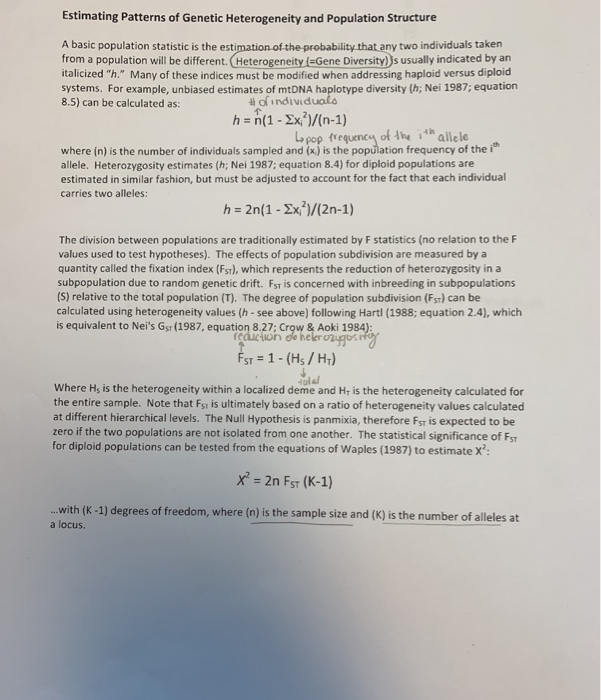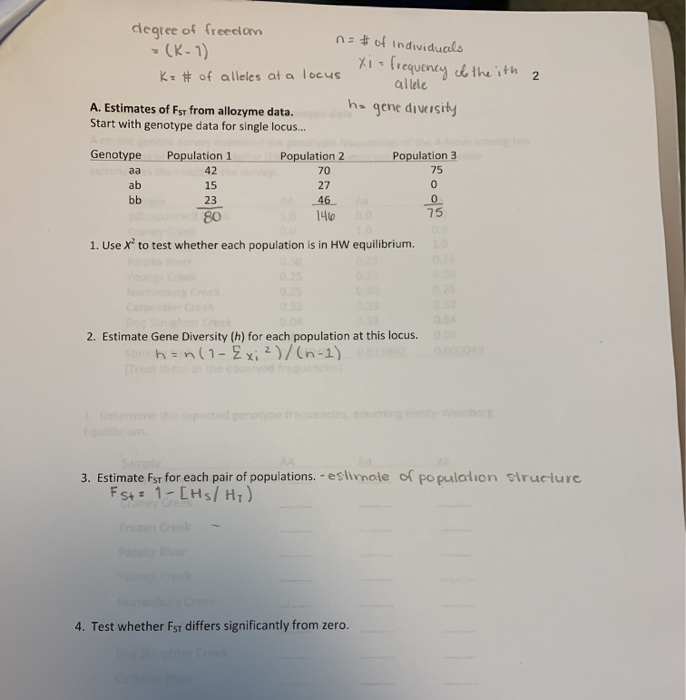Answered step by step
Verified Expert Solution
Question
1 Approved Answer
Estimating Patterns of Genetic Heterogeneity and Population Structure A basic population statistic is the estimation of the probability that any two individuals taken from


Estimating Patterns of Genetic Heterogeneity and Population Structure A basic population statistic is the estimation of the probability that any two individuals taken from a population will be different. Heterogeneity (=Gene Diversity) is usually indicated by an italicized "h." Many of these indices must be modified when addressing haploid versus diploid systems. For example, unbiased estimates of mtDNA haplotype diversity (h; Nei 1987; equation 8.5) can be calculated as: of individuals h = n(1 - x)/(n-1) Lapop frequency of the ith allele where (n) is the number of individuals sampled and (x) is the population frequency of the ith allele. Heterozygosity estimates (h; Nei 1987; equation 8.4) for diploid populations are estimated in similar fashion, but must be adjusted to account for the fact that each individual carries two alleles: h = 2n(1 - x,)/(2n-1) The division between populations are traditionally estimated by F statistics (no relation to the F values used to test hypotheses). The effects of population subdivision are measured by a quantity called the fixation index (FST), which represents the reduction of heterozygosity in a subpopulation due to random genetic drift. Fst is concerned with inbreeding in subpopulations (S) relative to the total population (T). The degree of population subdivision (FST) can be calculated using heterogeneity values (h-see above) following Hartl (1988; equation 2.4), which is equivalent to Nei's GST (1987, equation 8.27; Crow & Aoki 1984): reduction of heterozygosity FST = 1 - (HS/HT) tolal Where H, is the heterogeneity within a localized deme and H+ is the heterogeneity calculated for the entire sample. Note that Fs, is ultimately based on a ratio of heterogeneity values calculated at different hierarchical levels. The Null Hypothesis is panmixia, therefore FST is expected to be zero if the two populations are not isolated from one another. The statistical significance of FST for diploid populations can be tested from the equations of Waples (1987) to estimate X: x = 2n FST (K-1) ...with (K-1) degrees of freedom, where (n) is the sample size and (K) is the number of alleles at a locus. degree of freedom = (K-1) n = # of Individuals Xi-frequency of the ith allele K= # of alleles at a locus A. Estimates of FST from allozyme data. Start with genotype data for single locus... h= gene diversity Genotype summaa Population 1 42 ab 15 bb 23 80 Population 2 70 Population 3 75 27 0 46 0 146 0.0 75 10 0.0 1. Use X to test whether each population is in HW equilibrium. 1.0 Creek 0.50 0.25 0.25 0:33 0.04 0.25 0.25 2. Estimate Gene Diversity (h) for each population at this locus. Stinch=n(1-2xi )/(n-1) [Treat these as the obs 1. Determine the expected uencies) 0.04 0.000049 encies, assuming Hardy-Weinberg Equilibrium. Sample 3. Estimate FST for each pair of populations. - estimate of population structure FS+ 1 [Hs/ H) Craney Creek Frozen Creek Paroka River Creek 4. Test whether FST differs significantly from zero. Dog Slaughter Creek
Step by Step Solution
There are 3 Steps involved in it
Step: 1

Get Instant Access to Expert-Tailored Solutions
See step-by-step solutions with expert insights and AI powered tools for academic success
Step: 2

Step: 3

Ace Your Homework with AI
Get the answers you need in no time with our AI-driven, step-by-step assistance
Get Started


